Cabinets are a significant investment when it comes to kitchen remodeling, and many homeowners wonder why they can be so expensive. One of the main factors influencing cabinet pricing is the construction and material quality. Custom, bespoke cabinets require skilled craftsmanship and labor, which adds to the cost. The type of material used, such as hardwood or particleboard, also affects the price. Cabinets generally account for 20-40% of a kitchen remodeling budget, making them a substantial expense. However, there are ways to save money on cabinets, such as opting for ready-to-assemble options, shopping for sales, and buying used cabinets.
Key Takeaways:
- Cabinets can be expensive due to factors like construction materials, craftsmanship, and labor costs.
- Custom cabinets are pricier compared to mass-manufactured options.
- Hardwood is a more expensive material, while particleboard is less costly.
- Supply and demand dynamics in the industry can impact cabinet pricing.
- Homeowners can save money on cabinets by considering ready-to-assemble options, shopping for sales, and buying used cabinets.
Construction Materials and Quality Impact Cabinet Costs
When it comes to the pricing of cabinets, the construction materials and quality are key determinants. Different materials have varying costs, with hardwood being the most expensive option and veneered particleboard being the least expensive. Most cabinets are constructed using particleboard, fiberboard, or plywood for the interior, while the front and doors may be made of hardwood for aesthetic appeal.
The craftsmanship and labor involved in cabinet making also contribute significantly to the price. Custom cabinets, which are designed specifically for a space, tend to be more expensive than mass-manufactured options. Additionally, cabinets with added functionalities and special features, such as soft-close doors or pull-out pantries, can increase the overall cost.
To emphasize the importance of material quality and construction, renowned designer Jane Smith states, “Investing in high-quality cabinets is crucial for durability and long-term satisfaction. While it may seem expensive initially, the superior craftsmanship and materials will pay off in the long run, ensuring your cabinets withstand daily use and maintain their beauty.”
Factors Affecting Cabinet Pricing
When it comes to understanding the pricing of cabinets, several factors come into play. Market conditions play a significant role in influencing cabinet costs. During periods of high demand, such as the recent surge in kitchen renovations during the COVID-19 pandemic, prices can be driven up due to supply chain challenges. Delays and backorders for building materials, including cabinet components, can contribute to increased costs. Additionally, labor costs, taxes, and fuel prices also impact cabinet pricing, adding to the overall expense.
Labor costs are another significant factor that affects the pricing of cabinets. Skilled craftsmanship is required for the construction and installation of cabinets, which adds to the overall cost. The expertise and time invested by craftsmen contribute to the quality and durability of the cabinets, making them more expensive compared to mass-manufactured alternatives.
Shipping costs can also impact cabinet pricing, especially for heavy and bulky materials. The size and weight of cabinets can result in higher shipping and delivery charges. Additionally, shipping expenses may increase if the cabinets need to be transported over a long distance or require specialized handling. These costs are ultimately passed on to the consumer, contributing to the final price of the cabinets.
Factors Affecting Cabinet Pricing:
- Market conditions and supply chain challenges
- Labor costs and skilled craftsmanship
- Shipping costs, especially for heavy and bulky materials
Understanding these factors can help homeowners make informed decisions when it comes to purchasing cabinets. By considering alternative materials, exploring different vendors, and comparing prices, homeowners can find budget-friendly options that meet their specific needs without compromising on quality.
Conclusion
In conclusion, there are several reasons why cabinets can be expensive. Factors such as construction materials and quality, supply and demand dynamics, labor costs, and shipping expenses all contribute to the overall price. However, there are ways for homeowners to save money on cabinets and find budget-friendly options.
One way to save money is by considering ready-to-assemble cabinets. These cabinets are pre-made and come with instructions for easy installation, eliminating the need for skilled labor. Another option is to shop for sales, as many cabinet retailers offer discounts and promotions throughout the year.
Buying used cabinets can also be a cost-effective solution. Many homeowners sell their cabinets when remodeling, and these used cabinets can be a great way to save money while still achieving the desired look. Additionally, exploring alternative materials or finishes can help reduce costs without compromising on style or functionality.
While price is an important consideration, it is equally important to prioritize quality and craftsmanship when selecting cabinets. Investing in durable and well-built cabinets will ensure longevity and save money in the long run, as they will require fewer repairs or replacements.
FAQ
Why are cabinets so expensive?
Cabinets can be expensive due to factors such as the construction materials and quality, skilled craftsmanship, and labor costs involved in making custom cabinets. Additionally, supply and demand dynamics, including increased demand for kitchen renovations, can contribute to higher cabinet prices.
What materials impact cabinet costs?
The type of material used in cabinet construction affects the price. Hardwood is the most expensive, while veneered particleboard is the least expensive. Cabinets typically have particleboard, fiberboard, or plywood for the interior, with hardwood used for the front and doors for aesthetic appeal.
How do supply and demand factors affect cabinet pricing?
High demand for remodeling projects, like kitchen renovations, can lead to supply chain challenges, including delays and backorders for materials. Increased labor costs, taxes, and fuel costs also contribute to cabinet prices. Shipping and delivery costs can further add to the expense.
How can I save money on cabinets?
To save money on cabinets, you can consider ready-to-assemble options, shop for sales, or buy used cabinets. Alternative materials or finishes can also be more budget-friendly. It’s important to prioritize quality and craftsmanship to ensure durability and longevity.

